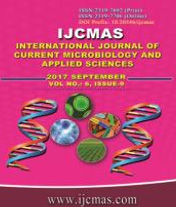


 National Academy of Agricultural Sciences (NAAS)
National Academy of Agricultural Sciences (NAAS)

|
PRINT ISSN : 2319-7692
Online ISSN : 2319-7706 Issues : 12 per year Publisher : Excellent Publishers Email : editorijcmas@gmail.com / submit@ijcmas.com Editor-in-chief: Dr.M.Prakash Index Copernicus ICV 2018: 95.39 NAAS RATING 2020: 5.38 |
Quince (Cydonia oblonga) is a hardy tree and very less susceptible to diseases. Therefore, used as a dwarfing rootstock for pear, depending on the scion desired and characteristics of the production area. Algal leaf spot is a foliar disease most commonly seen in warm humid climate or in greenhouse conditions. The spots were circular or blotchy in shape, 1-5mm in size and were somewhat raised from the plant surface. The edges of the spots were wavy or feathered. They varied in colour from a crusty grey-green to yellowish orange. The severity of the disease was rated 15-20 per cent on 0-5 scale. Based on morphological characteristics viz., sporangiophore, head cell and sporangiate laterals (suffultory cell and sporangium) the algal leaf spot of quince was found to be associated with Cephaleuros virescens. The measurement of sporangiophores varied from 305.3-670.4 x 11.1 -19.2 µm (Av. 472.3 x 14.5 µm), sporangia from 22.4-32.8 x 16.8-23.07 µm (Av. 27.6 x 19.9 µm) and that of head cell from 30.2- 57.4 x 29.4- 56.2 µm (Av. 43.6 x 42.5 µm). The number of septa of sporangiophores varied from 4-8.This is the first report on the occurrence of algal leaf spot of quince caused by Cephaleuros virescens from Himachal Pradesh, India.
 |
 |
 |
 |
 |